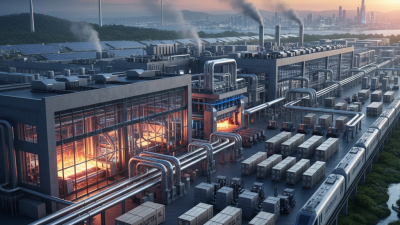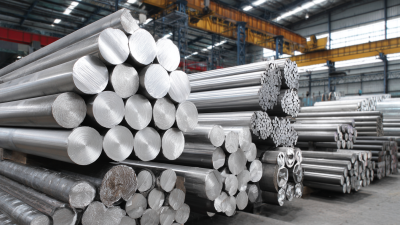Top 10 Stainless Steel Supplier Factors Influencing Market Growth and Demand in 2023
In 2023, the market for stainless steel continues to evolve, driven by a multitude of factors that significantly influence both growth and demand. As industries increasingly recognize the fundamental role stainless steel plays in various applications, understanding the key elements that affect the decisions of stainless steel suppliers becomes essential for stakeholders. This article delves into the top 10 factors that are shaping the landscape of stainless steel supply, highlighting the critical insights for suppliers and buyers alike.

The increasing emphasis on sustainability and eco-friendly practices is a vital factor in the current stainless steel market dynamics. Suppliers are not only expected to provide high-quality materials but also to demonstrate responsible sourcing and production methods. Additionally, technological advancements and innovations in production processes are enhancing the efficiency and quality of stainless steel, which is paramount for suppliers aiming to meet the rising demand. This exploration will provide a comprehensive overview for suppliers to adapt and thrive in a competitive environment, ultimately benefiting the end-users who rely on stainless steel in their manufacturing and construction activities.
Key Trends in Stainless Steel Demand: Analysis of Market Growth in 2023
The stainless steel market is poised for significant growth, influenced by various key trends observed in 2023. Notably, the global stainless steel market size is projected to increase from USD 329.90 billion in 2025 to USD 308.49 billion by 2033, reflecting a compound annual growth rate (CAGR) of 6.4%. This growth trajectory highlights the robust demand for stainless steel across multiple sectors, particularly in construction, automotive, and consumer goods, where its durability and resistance to corrosion play a vital role.
Additionally, the stainless steel seamless pipes market specifically is anticipated to reach USD 5.15 billion by 2030, underlining the material's crucial role in high-performance applications. This surge in demand is driven by advancements in manufacturing technologies and an increasing focus on sustainable practices within the industry. Moreover, the broader trends in related markets, such as the carbon steel sector projected to reach USD 1.2 trillion by 2030, indicate a dynamic interplay between carbon and stainless steel products as manufacturers adjust their supply chains to meet evolving demands. These interconnections within the metal market landscape suggest a thriving environment for stainless steel suppliers in 2023 and beyond.
Analysis of Stainless Steel Demand Factors in 2023
Impact of Construction Industry Expansion on Stainless Steel Supply and Pricing
The expansion of the construction industry is significantly impacting the supply and pricing of stainless steel in 2023. As construction projects ramp up globally, the demand for durable and corrosion-resistant materials like stainless steel is surging. This increase in demand not only affects supply chains but also leads to fluctuations in pricing, as suppliers strive to meet the growing needs of builders and developers. Additionally, the emphasis on sustainable building practices is driving more construction firms to opt for stainless steel due to its recyclability and longevity.
Moreover, the interplay of market forces, including tariffs imposed on metals and shifts in base metal demand under China's 15th Five-Year Plan, is shaping the landscape for stainless steel procurement. With China moving towards green technology and electrification, the focus on stainless steel as a vital component in these sectors is likely to grow stronger. As a result, manufacturers must navigate these dynamics carefully to maintain competitiveness while addressing the challenges posed by supply constraints and pricing volatility in the market.
Technological Advancements in Stainless Steel Production Enhancing Market Competitiveness
Technological advancements play a pivotal role in the growth of the stainless steel market, particularly in the production of seamless pipes. Innovations such as piercing and extrusion techniques have revolutionized manufacturing processes, enhancing efficiency and reducing waste. The stainless steel seamless pipes market, segmented by grade—including austenitic, ferritic, and duplex varieties—has been fueled by these technological improvements. Reports indicate that seamless pipes are increasingly sought after in various end-use industries, notably oil and gas, due to their superior strength and resistance to corrosion.
The increased competitiveness in the stainless steel sector can also be attributed to automation and smart manufacturing solutions, which lower production costs and increase throughput. This advancement is particularly crucial as global demand continues to outpace supply, leading to projections of robust growth for the sector. For instance, the rise of the acupuncture needles market, with a forecasted CAGR of 8.5%, underscores a burgeoning need for quality stainless steel components, highlighting the interconnected nature of these markets.
Tips: To stay ahead in this competitive landscape, businesses should invest in the latest production technologies and upgrade their facilities to embrace automation. Additionally, fostering partnerships with technology providers can offer insights and enhance production capabilities in response to market demands.
Top 10 Stainless Steel Supplier Factors Influencing Market Growth and Demand in 2023
| Factor | Impact on Market Growth (%) | Description | Technological Advancements |
|---|---|---|---|
| Rising Construction Activities | 25 | Increase in demand for stainless steel in construction and infrastructure projects. | Innovative techniques in steel fabrication. |
| Automotive Industry Growth | 20 | Increasing use of stainless steel for vehicle parts due to its durability. | Advancements in lightweight steel production. |
| Sustainability Initiatives | 18 | Demand for recyclable materials is pushing stainless steel production. | Eco-friendly production methods. |
| Smart Manufacturing | 15 | Integration of automation in production leading to efficiency. | Internet of Things (IoT) in production processes. |
| Emerging Markets | 22 | Growing economies requiring substantial infrastructure development. | Localized production technologies. |
| Competitive Pricing Strategies | 17 | Price competition among suppliers influencing market dynamics. | Automation reducing production costs. |
| Innovations in Product Design | 21 | New designs improving applications in various industries. | Advanced 3D modeling and manufacturing techniques. |
| Global Supply Chain Dynamics | 30 | Changes in supply chain management affecting availability. | Blockchain for enhanced traceability. |
| Government Regulations | 19 | Policies promoting the use of stainless steel in various sectors. | Compliance with sustainability standards. |
Sustainability Initiatives Driving Innovation and Demand in Stainless Steel Manufacturing
Sustainability initiatives are becoming central to the growth and innovation of the stainless steel manufacturing sector. As the demand for eco-friendly materials rises, manufacturers are increasingly adopting sustainable practices to reduce their environmental footprint. This shift not only enhances the appeal of stainless steel products but also aligns with global trends towards cleaner production processes. Companies are investing in advanced metallurgy and innovative solutions that prioritize resource efficiency and minimize waste, positioning themselves as leaders in an industry that is evolving rapidly to meet modern consumer expectations.
The focus on sustainability is also reflected in the broader market dynamics, as industries increasingly favor materials that contribute to their own environmental goals. For example, the growing water bottle market underscores this trend, with consumers gravitating towards sustainable packaging materials. As stainless steel continues to be recognized for its recyclability and longevity, manufacturers are poised to capitalize on this demand. The strategic integration of sustainable initiatives within manufacturing processes not only drives innovation but also sustains the competitive edge of companies in the ever-evolving stainless steel market.
Global Trade Policies and Tariffs: Their Role in Shaping the Stainless Steel Market Landscape
The global stainless steel market is significantly impacted by trade policies and tariffs, which shape its landscape in 2023. According to a recent report by Smithers Pira, a leading consulting firm, the overall demand for stainless steel is projected to grow by 3.5% annually, largely influenced by governmental regulations and international trade agreements. Policies that encourage domestic production can lead to an increase in local suppliers, which in turn could reduce reliance on imports and stabilize prices.
Conversely, tariffs imposed by major economies, such as the U.S. and the European Union, can have a detrimental effect. A study by the International Stainless Steel Forum (ISSF) found that the imposition of tariffs on stainless steel imports led to a 15% price increase within the U.S. market in 2022, shifting demand patterns and prompting manufacturers to seek alternative materials. As countries reevaluate their trade positions, the dynamic between demand and supply in the stainless steel market continues to evolve, highlighting the crucial role of these policies in shaping future growth trajectories.
Related Posts
-

The Ultimate Guide to Choosing the Right Stainless Steel Supplier for Your Projects
-

7 Best Practices for Choosing the Right Steel Wire for Your Projects
-

The Ultimate Guide to Choosing the Best Tie Wire for Construction Projects
-

Revitalize Your Cleaning Routine: Discover the Power of Steel Brushes for Every Task
-

Understanding the Essential Role of Steel Rope in Everyday Applications
-

Exploring the Impact of Wire Brush Innovations at the 2025 China Import and Export Fair
